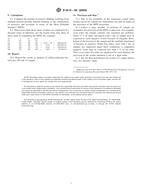Potřebujeme váš souhlas k využití jednotlivých dat, aby se vám mimo jiné mohly ukazovat informace týkající se vašich zájmů. Souhlas udělíte kliknutím na tlačítko „OK“.
ASTM D4412-84(2009)
Standard Test Methods for Sulfate-Reducing Bacteria in Water and Water-Formed Deposits
Automaticky přeložený název:
Standardní zkušební metody pro sulfát redukujících bakterií ve vodě a vodě, tvořil Vklady
NORMA vydána dne 1.5.2009
Informace o normě:
Označení normy: ASTM D4412-84(2009)
Poznámka: NEPLATNÁ
Datum vydání normy: 1.5.2009
Kód zboží: NS-27121
Počet stran: 3
Přibližná hmotnost: 9 g (0.02 liber)
Země: Americká technická norma
Kategorie: Technické normy ASTM
Anotace textu normy ASTM D4412-84(2009) :
Keywords:
Bacteria/bacterial control--water, Most-probable-number technique, Pathogens--water, Sulfate content--water, Thermophilic sulfate-reducing bacteria, Water-formed deposits, ICS Number Code 07.100.20 (Microbiology of water)
Doplňující informace
| Significance and Use | ||||||||||
|
Sulfate-reducing bacteria are widely distributed in marine and fresh water muds which, in consequence, frequently are laden with the hydrogen sulfide produced by these organisms during dissimilatory sulfate reduction. It has been reported that Desulfovibrio can form as much as 10 g of sulfide per litre during active multiplication. Sulfate-reducing bacteria can cause the external or internal corrosion of water or wastewater pipelines and pipelines for petroleum and natural gas. The formation of galvanic cells by massive growth of sulfate-reducing bacteria under suitable conditions makes the corrosion much worse than just the effect of the hydrogen sulfide on the metal or concrete. |
||||||||||
| 1. Scope | ||||||||||
|
1.1 These test methods cover the procedure for the detection and enumeration by the most probable number (MPN) technique of sulfate-reducing bacteria in water or water-formed deposits. 1.2 Two media preparations are provided. Medium A which is prepared with reagent grade water, and Medium B which is prepared using the water to be sampled as the water source. Medium B is offered for those special conditions where sulfate-reducing bacterial strains have adapted to atypical non-fresh water environment. 1.3 For the isolation and enumeration of thermophilic sulfate-reducing bacteria encountered in waters associated with oil and gas production, all broths, dilution blanks, and incubations must be maintained at temperatures of at least 45°C and preferably within 5°C at the sample temperature. 1.4 The sensitivity of these test methods can be increased by purging the dilution blanks and tubes of media with nitrogen immediately prior to use. 1.5 The analyst should be aware that adequate collaborative data for precision and bias statements as required by Practice D 2777 are not provided. See Section 11 for details. 1.6 The values stated in SI units are to be regarded as standard. No other units of measurement are included in this standard. 1.7 This standard does not purport to address all of the safety concerns, if any, associated with its use. It is the responsibility of the user of this standard to establish appropriate safety and health practices and determine the applicability of regulatory limitations prior to use. |
||||||||||
| 2. Referenced Documents | ||||||||||
|
Odebírejte informace o nově vydaných normách ZDARMA:
Chcete pravidelně odebírat informace o nově vycházejících normách z celého světa a to zcela zdarma?
Přihlašte se k odběru. Vše je velice jednoduché a absolutně ZDARMA.
Na výběr máte vydavatele z celého světa.




 Cookies
Cookies
